No Knead Sourdough Bread
With a beautiful crust and soft texture, this no knead sourdough bread recipe is straightforward and easy to follow with only 10 minutes of hands on time. Just mix the dough, let it sit, then bake that night or the next morning!
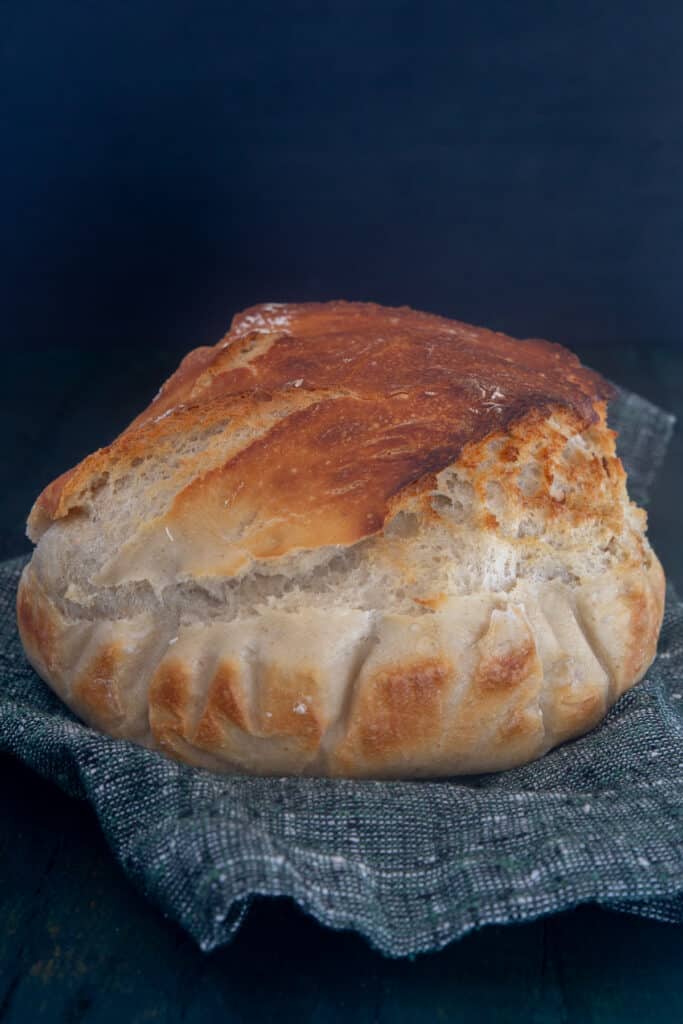
For this recipe you can use either your homemade sourdough starter or this sourdough starter with yeast.
This no knead sourdough bread is perfect for beginners and busy people! It’s a no fuss way to get an artisan loaf of bread without a lot of hands-on time in the kitchen.
If you have been looking for a sourdough bread recipe that returns consistent results every time, this no knead sourdough is a great place to start. It’s the perfect recipe to start with if it’s your first time baking sourdough!
With a crunchy crust, soft crumb and wonderful flavor this loaf is also a beauty to look at whether you enjoy a slice at dinner, in the morning or slathered with butter for a snack.
Table of Contents
Why You’ll Love This No-Knead Sourdough Bread Recipe
- No kneading: Since this is a no-knead sourdough, there is no kneading, stretching, folding or need for a mixer! Gluten develops during the long fermentation process and helps create the air pockets in the sourdough.
- Easy to handle: This sourdough no knead bread only requires medium hydration and is easy to shape into a beautiful loaf.
- Flexible: If baking sourdough bread plans change, just place the dough in the fridge to slow the process down.
- Flavorful results: This bread still has all the delicious tangy flavor sourdough is known for!
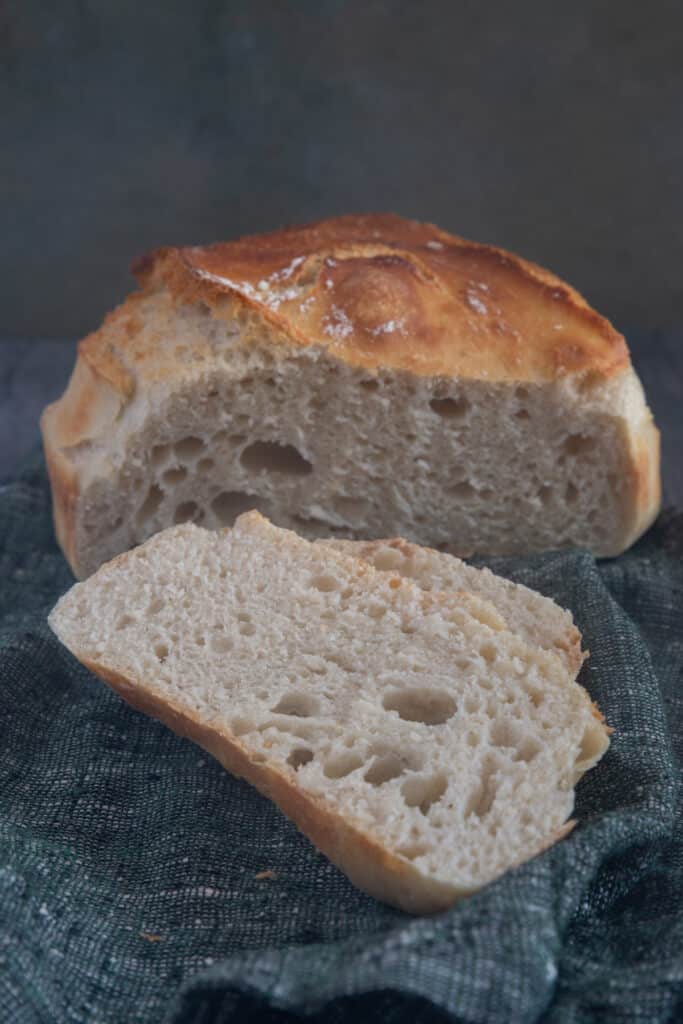
Ingredients Needed
- Sourdough starter: Either use a homemade starter with or without yeast or you can purchase a sourdough starter as well.
- Flour: Either bread flour or all purpose flour can be used.
- Active dry yeast: This will help your sourdough rise faster.
- Sugar: Honey or granulated sugar is used to feed the yeast.
- Water: For hydration.
- Salt: Adds taste.
How to Make No Knead Sourdough Bread
For this no-knead sourdough bread recipe, the instructions include adding yeast to give it a faster rise. You can opt to not do this but will need to plan on a longer rise time. See detailed instructions for that method in the recipe card.
Yeast mixture: In a small bowl combine sugar of choice and ¼ cup of water, sprinkle your active dry yeast on top and let sit for 10 minutes. Stir to combine.
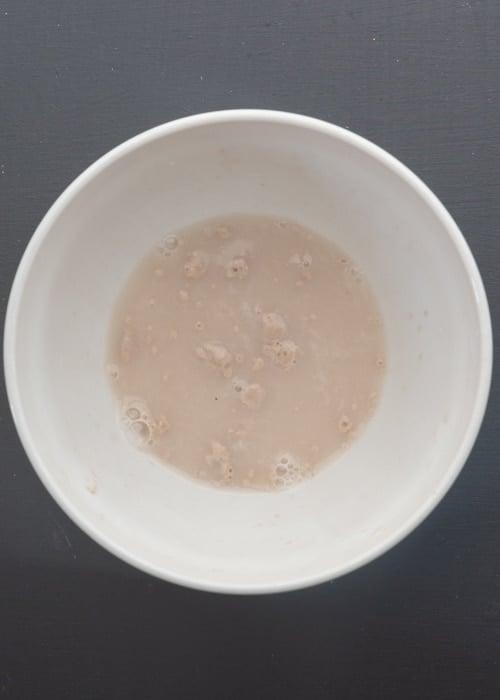
First rise: In a medium bowl mix together the remaining water and sourdough starter.
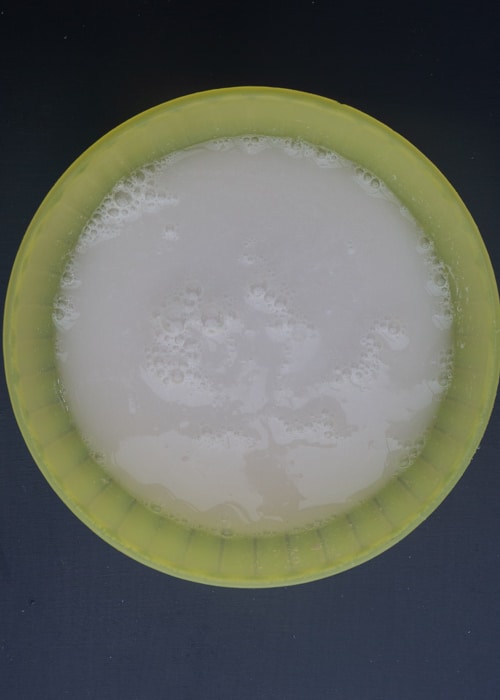
In another large mixing bowl add the flour then make a well in the middle and add the yeast mixture and sourdough starter mixture. Start to mix it together with a fork then add the salt and continue to mix until well combined.
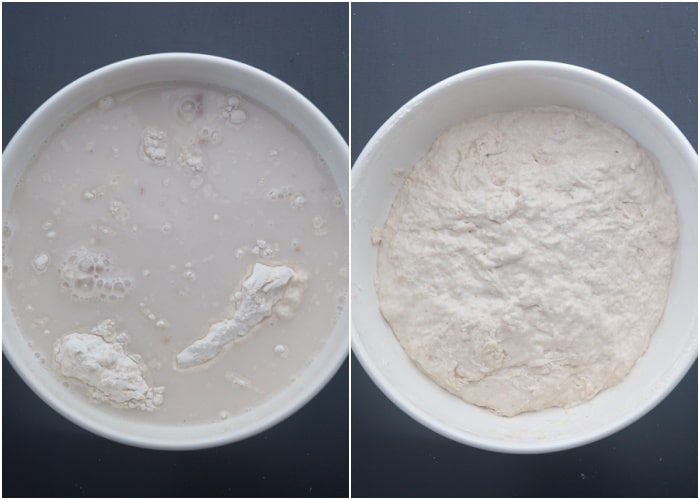
Sprinkle the top with a tablespoon of flour to prevent sticking. Cover the bowl and refrigerate for at least 8 hours or up to 24 hours.

Second rise: Remove the sourdough bread dough from the fridge and bring to room temperature which should take around 30 minutes. With the help of a spatula transfer the dough (floured side up) onto a floured flat surface and gently fold to form a round or oval ball. Be careful not to break any air bubbles that form. Place the dough in a parchment paper lined dutch oven or high cake pan. Cover the pan and let rise in a warm draft free area for 2-3 hours if not using yeast or 1-2 hours if using yeast.

Bake: Preheat the oven to 420 degrees F and bake for 25-30 minutes. Move immediately to a wire rack to cool completely before slicing. Enjoy!

What Is Sourdough Bread?
Sourdough bread is a bread made without commercial yeast that relies on a homemade sourdough starter, you may even hear the starter called a ‘wild yeast’ since it is all natural and relies on fermentation.
It is that fermentation that gives sourdough its unique flavor and taste! Sourdough is also much easier to digest because of the fermentation.
All you need is a little time to make a sourdough starter at home. My recipe for a traditional sourdough starter at home takes around a week to make, but if you are in a hurry you can make this sourdough starter with yeast which takes only 24 hours!
Flour selection
For this no knead sourdough recipe you can use either all purpose flour or bread flour. Since we are relying on time to strengthen our sourdough, a medium to high protein content in your flour will work best. Just check the back of your flour bag and the protein content will be listed there.
Bread flour protein is 12-14% and will provide the best strength, while all purpose flour with a protein content around 11.7% produces a bread that is more tender and delicate.
Whole wheat flour while bringing more nutrition to your bread is a significantly higher protein content and needs to be treated differently, check out my whole wheat sourdough bread recipe for working with that type of flour.
Tips for Success
- Rise time varies: Look at your dough vs. the clock during your first long rise time. Your dough should be domed, springy and if you shake the bowl it should give a little jiggle.
- Don’t forget the salt: It adds to the taste.
- Measure flour accurately: A kitchen scale is best and remember to ‘zero out’ the weight of your bowl or measuring cup.
- Gummy bread: Don’t underproof your dough. Ensure your starter is active and strong and allow enough time for your dough to rise properly. If underproofing is not the culprit, buy an oven thermometer and check the temp of your oven for accuracy.
- Cover your bowl: Use a towel or plastic wrap to ensure that a less than pleasant crust doesn’t develop.
- Don’t forget to preheat your oven: This will ensure your no knead sourdough bread bakes accurately.
- Internal temp of bread: If you are not sure your bread is done baking, test it with an internal thermometer. It should be around 205 – 210 degrees F.
Baking Schedule for No-Knead Sourdough Bread
This timeline is just an example, your rise time might be different due to kitchen temps or if you have decided to use the active dry yeast to help speed things up or not.
- 8 a.m. (the day before baking): 8-12 hours before you plan to mix your dough, feed your starter. If you would like a more tangy bread, skip this step.
- 8 p.m. (the day before baking): Mix your dough and then proof the dough overnight in the refrigerator.
- 8 a.m.: Remove dough from the fridge and bring to room temperature.
- 8:30 a.m.: Place dough in the pan and rise again in a warm area.
- 9:30 a.m. – 12:30 p.m.: Depending on if you have used yeast or not, your sourdough is now ready to bake.
- 12:30 p.m.: Bake bread.
- 1:00 p.m.: Enjoy your freshly baked no knead sourdough bread!

FAQs
How does no knead sourdough work?
Traditional bread with yeast relies on kneading the dough to develop gluten and strengthen the bread. Sourdough on the other hand naturally gets its strength from the long fermentation process. Some methods in sourdough baking will require you to give the bread a hand in developing additional strength by stretching and folding the dough multiple times. You may hear this called lamination.
This no-knead sourdough, though, relies solely on the long fermentation process to develop its strength. So technically we could also call it a ‘no stretching and folding’ method as well!
What equipment do I need?
While there are some fun optional items such as a bread proofing basket (Banneton), dough whisk and dough scraper, these are optional and you really only need a few pieces of equipment to make this no knead bread. The essential tools include a large bowl, kitchen scale, measuring cup, parchment paper and a cast iron Dutch oven or high cake pan.
What air temperature should my kitchen be at for the best rise?
For your second rise a warm draft free will provide the best rise. I wouldn’t stress too much on the air temperature as it will fluctuate depending on the season, but if you are looking for a number, 72-77 degrees F would be ideal. This may require finding a warmer spot in your kitchen or house during the winter and a cooler spot during the summer.
Do I need to worry about the dough’s hydration?
As different flour absorbs different levels of moisture, your dough might behave differently depending on the flour used. A wet dough produces beautiful air pockets while a dryer dough will be less airy and dense, but is easier to work with. For beginners, follow this recipe exactly for great results as it is around 70-75%% hydration. As you get more comfortable working with sourdough, you can try to increase the hydration to around 80%.
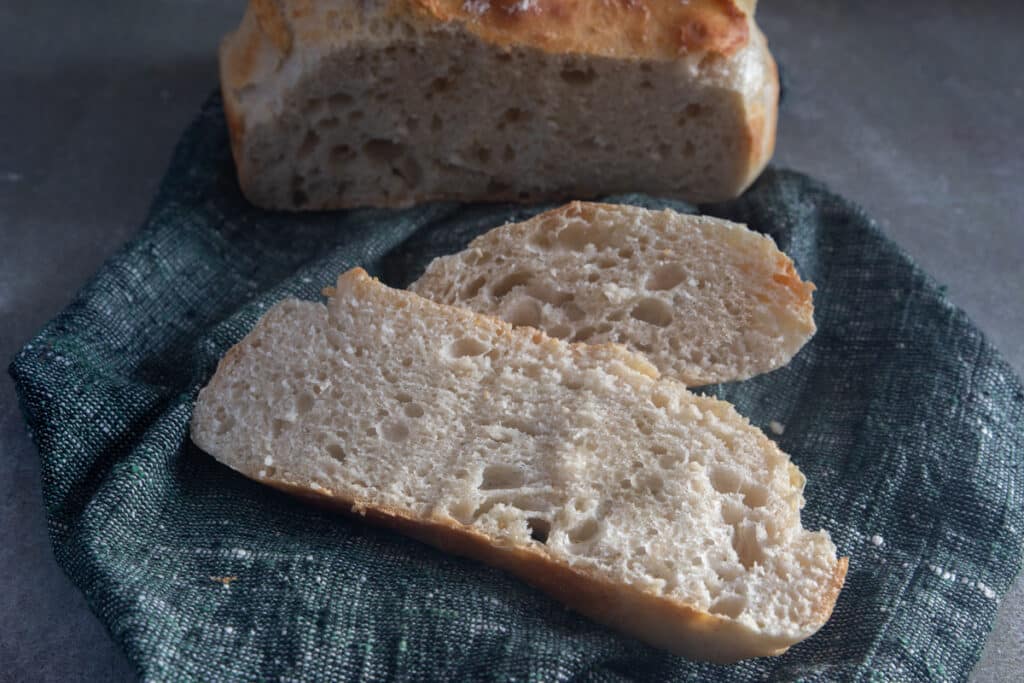
More Sourdough Recipes
- Rustic sourdough buns
- Easy sourdough focaccia
- Sourdough pretzels
- Sourdough dinner rolls
- Sourdough crescent rolls
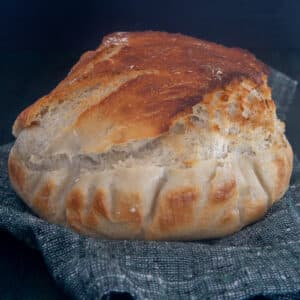
No Knead Sourdough Bread
Ingredients
- lukewarm water 345 grams
- 1 teaspoon honey or granulated sugar
- active sourdough starter* 100 grams
- ¾ teaspoon active dry yeast
- flour all purpose or bread flour 465 grams
- 1½ teaspoons salt
**For this recipe you can use either this sourdough starter or this sourdough starter with yeast!
Instructions
Before starting see notes below.
- In a small bowl combine the honey and water, sprinkle the yeast on top and let sit for 10 minutes. Stir to combine.
- In a medium bowl mix together the remaining water (or all the water if not using yeast) and sourdough starter.
- In a large bowl add the flour, make a well in the middle and add the yeast mixture (if using) and sourdough starter mixture, start to mix together with a fork, add the salt, continue to mix until well combined. Sprinkle the top with a tablespoon of flour. Cover the bowl and refrigerate for at least 8 hours or up to 24 hours.
- Remove the dough from the fridge, let sit 30 minutes at room temperature. With the help of a spatula transfer the dough (floured side up) onto a floured flat surface and gently fold to form a round or oval ball, careful not to break any air bubbles that form, place the dough on a parchment paper lined dutch oven or high cake pan. Cover the pan and let rise in a warm draft free area for 2-3 hours / 1-2 hours if using yeast until nice and puffy.
- Pre-heat oven to 420F.
- Bake for approximately 25-30 minutes. Move immediately to a wire rack to cool completely before slicing. Enjoy!
